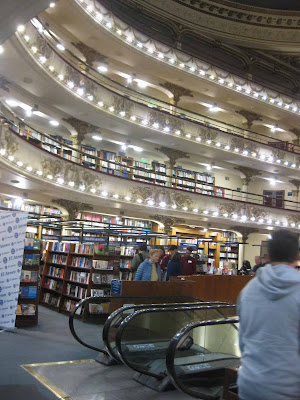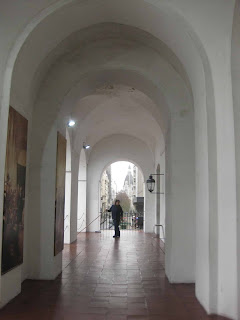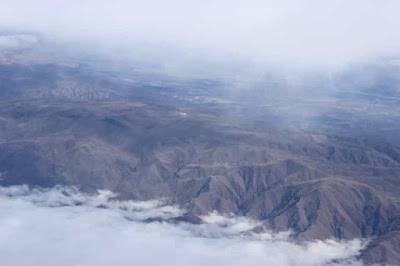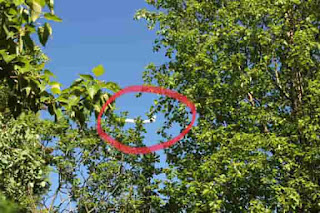In the week we’ve been here, I’ve heard a lot about the terrible Argentine economy these days, About how corruption has badly hurt every day Argentinians. How the Peso has dropped drastically in value. I’ve tried to include pictures of people in the posts I’ve done so that you can see that this is a population that doesn’t look that different from people in the states. Men in public are wearing jeans and tennis shoes. Women are dressed in a range from casual to chic.
There are lots of coffee shops with people sitting inside and out with coffee and pastries and more substantial snacks. There was a strong middle class.
I keep hearing that Argentina was once one of the richest countries in the world, per capita.. Here’s the beginning of an article on that by an Argentinian.
In the textbook “Economics”, written by the Nobel Prize in Economics Paul Krugman together with his wife Robin Wells, in the chapter on introduction to macroeconomics, they make a small comparison between the evolution of Canada and Argentina. With the title “A story of two countries”. “One of the most informative contrasts is between Canada and Argentina, two countries that, at the beginning of the 20th century, seemed to be in a good economic position. From today’s point of view, it is surprising to realize that Canada and Argentina looked pretty much alike before the First World War. (…) Economic historians believe that the average level of per capita income was almost the same in the two countries until the 1930s.”[1]
The Peso was down 52% in 2018 (the most of any country listed in the article) The link provides five other factors leading to Argentina’s economic crisis.
People were limited to taking only $200 (in US currency in one case I heard about) per day.
People jog, go to the gym, ride bikes, go to the university, and all things Americans and Europeans do, but they are also feeling the pinch. Homeless are sleeping on the streets and in the subway walkways - but not as bad as I’ve seen in Los Angeles, San Francisco, Seattle, and even Anchorage. But then I’ve not seen a lot of the city, so maybe there are more.
People look weary and our host and teachers and people we meet tell us the same story. Life is getting harder and harder. On the other hand, university is free, and we met a man waiting for the bus today who was born in Buenos Aires, but grew up in Miami. He’s back here going to the university.
All this is prelude to the book store we went to yesterday - the biggest one in Argentina.
Tucked away in Barrio Norte, Buenos Aires is a beautiful shop that every bookworm would love to visit, called El Ateneo Grand Splendid. It is built within the almost 100-year-old Grand Splendid Theater, which opened in 1919. The premises were later converted into a movie theater and eventually, in 2000, it was transformed into the El Ateneo Grand Splendid bookstore, which currently welcomes over one million book lovers each year.
Below is my picture, but go to the link to see much better pictures of the building than I have. And to learn more about the history of this giant bookstore. https://www.boredpanda.com/buenos-aires-bookstore-theatre-el-ateneo-grand-splendid/?utm_source=google&utm_medium=organic&utm_campaign=organic
I’m going to focus mostly on the Argentine politics section of the store which is a relatively small part of the whole bookstore. So I’ll add just a couple of pictures of other nearby titles.
I don’t recall ever seeing a section on Military Dictatorships in a book store before.
I Do Not Forgive: The Testimony of Erika Lederer, Daughter of a Genocial Obsterician.
Google isn’t giving me anything in English - even though I’m asking for English - on Erika Lederer. Here’s a translation from google. There are some oddly gendered pronouns. Is this book available in English? I’m guessing not:
The Spanish version was from Planeta de Libros.
She is the first daughter of medical captain Ricardo Lederer, second chief of clandestine maternity in Campo de Mayo during the period of State terrorism. Raised in a professional middle class family, she attended a private school in the German community of Villa Ballester, where she began to read her first philosophy books. His father was an obstetrician doctor, a commando soldier and part of the carapintada uprising of the La Tablada barracks, in 1987. The union is also called, in the book Nunca más, as "the madman with pretensions to purge the race."She is a lawyer from the University of Buenos Aires, specializing in Family Mediation. Works in family mediation in confinement contexts. As she defines it, this is "doing magic; Provide tools to build an alternative story, that is habitable for the person. "He practiced swimming, running and today pole dance; disciplines in which are the metaphors that mark his life in different stages.He joined the founding group of "Disobedient Stories" and, later, "Former children and former daughters of genocide for Truth, Memory and Justice".
Perished:: Who wins the America Cup of orruption?
[While writing this post, the screen here went blank. I was able to post it - and what I’d done was still there, but I wasn’t finished. So now I’m finiahing.]
Another book in that section.
Google translates this as Under the Water, but I’m guessing that it might mean Under Water. I suspect any English speaker can decipher the subtitle.
Here’s one book that appears to look at how the world’s torments impact the River of Silver (the area around Buenos Aires.). And another that seems to look the other way around - how the torments of Argentina affect the world.
And as promised, a couple of books from different sections.
Our Spanish classes ended today. I learned a lot, but I’m still tongue tied when I get out of class. I have a sense of how my two year old granddaughter feels as she gets more words and sentences out effectively. Actually, she’s advancing much faster than I am. Both of us had excellent teachers.
And J got her stitches out today. If I posted pictures of the doctor stitching her up and the nurse taking them out today, the surroundings look pretty much the same. Here it was the German Hospital of Buenos Aires. Looks a lot like Providence Anchorage, but more patients, and better places to eat in the neighborhood.
And I finally broke down and went to the travel agent recommended by the language school, to plan out the rest of the trip. We aren’t tour people, but for the national park - Iguasu - it just seems a lot easier and they did some more planning until the rest of the family is here for the eclipse. Then we have more time to plan out.
<











































